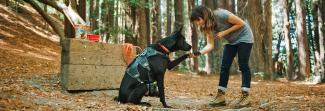Getting a new puppy is a fun, exciting, entertaining and sometimes exhausting event. Once you bring home your new furry family member, you might be left with the “what now?” feeling. If there’s one thing I’ve learned with puppy training, it’s to have a plan and stick with it. Here are some tips for finding success training your new pup.
Make a list of training and behavior goals; it doesn’t matter if these are goals for tomorrow or for the next two years. Usually for puppies, the immediate goals are housebreaking, crate training, and starting general manners. Then, you can start to think about your goals for him as an adult dog. Do you want your dog to walk nicely on a leash or travel downtown with you for coffee and shopping? No matter what the goals are, it’s always best to start early with training so that your puppy knows what’s expected of him.
To truly find success with your puppy and be effective in your training efforts, you want to be a trainer, not a tester. Being a tester means taking the “let’s just see how it goes approach,” which leaves too much room for failure. It’s all too often that we hear about a puppy performing well in the classroom or at home, but when the skill is taken out of the home, there is no success. This is because it’s harder for puppies to focus and work in a novel environment. They also don’t generalize lessons well, so we need to help them along with this process. I refer to the world outside of the classroom or home as ‘Doggy Disneyland.’ It’s full of new sights, sounds and smells, all of which are exciting and distracting. Part of finding success in these new environments is to ease into them and not just throw your puppy in head first with unrealistic expectations.
Here are some tips to help find success when you start expanding your puppy’s training world:
- Ease into new environments. A good way to see if your puppy can work with new distractions is to take your in-home training to simple places, like your yard or porch. Let them learn to work outside the house and engage with you. Keep these sessions short and fun, with lots of high-value reinforcements. It’s always good to have your dog work for you right out of the house, as this gets him focusing right away.
- Apply at-home lessons in public. When you’re ready to expand to more public places, be sure to engage your puppy in work right away. This can mean that right when you get out of the car you ask him to sit or do focus work. Keep in mind that as you raise the difficulty level of training, you may need to raise the reinforcement value as well.
- Let him explore. When you’re training in a new place, let your puppy check things out for a little bit and then re-engage him in work. You want him to be able to check things out and then ignore those things when you ask him.
- Keep your training in new places simple to start. If you take your puppy downtown for the first time and expect him to walk perfectly on leash the whole time, you’ll find yourself frustrated within minutes. A good way to start is to let him check things out for a little bit and then do some training that doesn’t involve a lot of movement, like a down-stay or sit-stay. By not moving a lot, you lower the risk of your puppy wanting to check everything out and increase the odds of him focusing and working for you.
Training at an appropriate pace will give you and your puppy the best chance for success. In addition, successful training will keep your puppy from developing bad habits, in turn making your life together much more fun and enjoyable.

